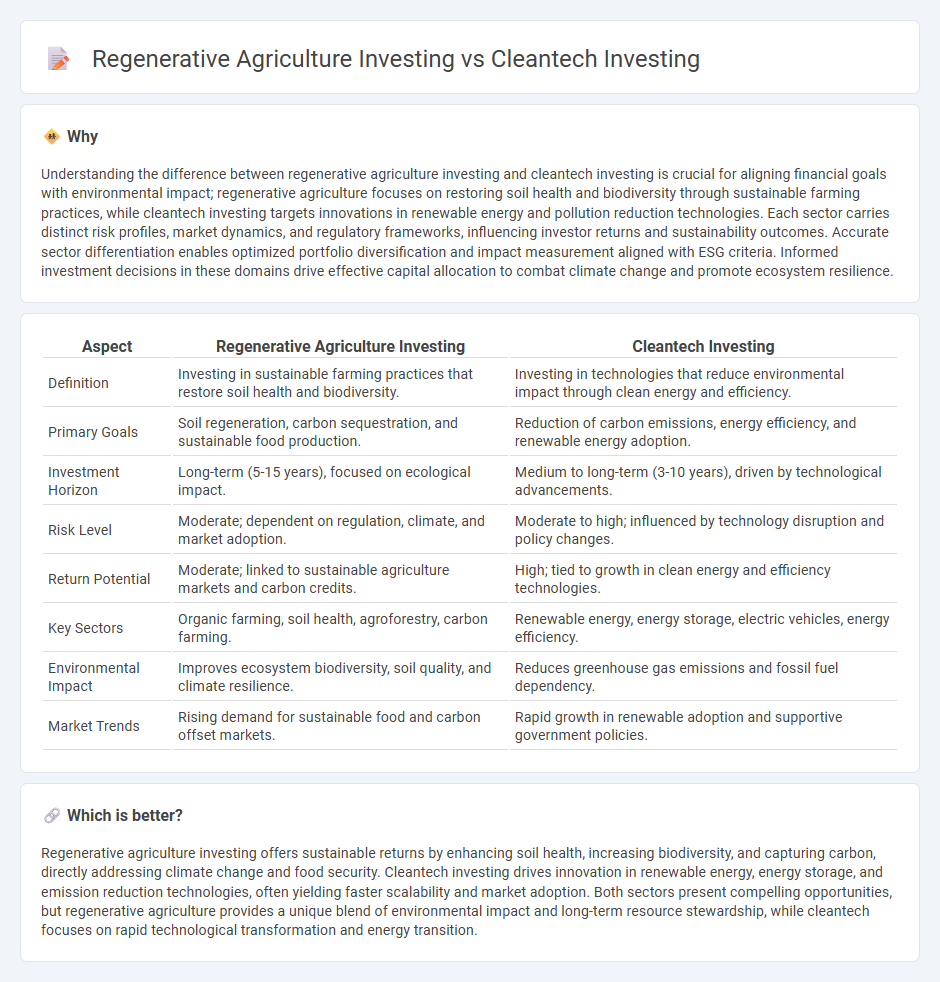
Regenerative agriculture investing focuses on sustainable farming practices that restore soil health and sequester carbon, driving long-term environmental and economic benefits. Cleantech investing targets innovative technologies aimed at reducing carbon emissions and increasing energy efficiency across various industries. Explore the distinct opportunities and impacts of these investment strategies to make informed decisions.
Why it is important
Understanding the difference between regenerative agriculture investing and cleantech investing is crucial for aligning financial goals with environmental impact; regenerative agriculture focuses on restoring soil health and biodiversity through sustainable farming practices, while cleantech investing targets innovations in renewable energy and pollution reduction technologies. Each sector carries distinct risk profiles, market dynamics, and regulatory frameworks, influencing investor returns and sustainability outcomes. Accurate sector differentiation enables optimized portfolio diversification and impact measurement aligned with ESG criteria. Informed investment decisions in these domains drive effective capital allocation to combat climate change and promote ecosystem resilience.
Comparison Table
| Aspect | Regenerative Agriculture Investing | Cleantech Investing |
|---|---|---|
| Definition | Investing in sustainable farming practices that restore soil health and biodiversity. | Investing in technologies that reduce environmental impact through clean energy and efficiency. |
| Primary Goals | Soil regeneration, carbon sequestration, and sustainable food production. | Reduction of carbon emissions, energy efficiency, and renewable energy adoption. |
| Investment Horizon | Long-term (5-15 years), focused on ecological impact. | Medium to long-term (3-10 years), driven by technological advancements. |
| Risk Level | Moderate; dependent on regulation, climate, and market adoption. | Moderate to high; influenced by technology disruption and policy changes. |
| Return Potential | Moderate; linked to sustainable agriculture markets and carbon credits. | High; tied to growth in clean energy and efficiency technologies. |
| Key Sectors | Organic farming, soil health, agroforestry, carbon farming. | Renewable energy, energy storage, electric vehicles, energy efficiency. |
| Environmental Impact | Improves ecosystem biodiversity, soil quality, and climate resilience. | Reduces greenhouse gas emissions and fossil fuel dependency. |
| Market Trends | Rising demand for sustainable food and carbon offset markets. | Rapid growth in renewable adoption and supportive government policies. |
Which is better?
Regenerative agriculture investing offers sustainable returns by enhancing soil health, increasing biodiversity, and capturing carbon, directly addressing climate change and food security. Cleantech investing drives innovation in renewable energy, energy storage, and emission reduction technologies, often yielding faster scalability and market adoption. Both sectors present compelling opportunities, but regenerative agriculture provides a unique blend of environmental impact and long-term resource stewardship, while cleantech focuses on rapid technological transformation and energy transition.
Connection
Investment in regenerative agriculture and cleantech focuses on sustainable innovation aimed at reducing environmental impact and enhancing resource efficiency. Both sectors prioritize technologies and practices that sequester carbon, promote renewable energy, and improve soil health, creating synergies that attract impact-driven investors. Capital allocation to these interconnected industries supports climate resilience and long-term ecological balance while delivering competitive financial returns.
Key Terms
Cleantech investing:
Cleantech investing centers on innovative technologies that reduce environmental impact by enhancing clean energy production, energy efficiency, and waste management, driving the global transition to a low-carbon economy. Market projections estimate the cleantech sector could reach $1.5 trillion by 2030, supported by governmental policies and increasing corporate sustainability commitments. Explore detailed insights on cleantech investment opportunities, emerging trends, and risk assessments to maximize your portfolio impact.
Renewable Energy
Investing in cleantech primarily targets cutting-edge renewable energy technologies such as solar, wind, and battery storage systems that reduce greenhouse gas emissions and enhance energy efficiency. Regenerative agriculture investing supports sustainable farming practices that restore soil health and sequester carbon, indirectly benefiting renewable energy by promoting ecosystem resilience. Explore how these investment strategies contribute uniquely to a low-carbon future and sustainable energy solutions.
Energy Efficiency
Cleantech investing prioritizes innovations in energy efficiency by supporting technologies such as advanced solar panels, smart grids, and energy storage systems that reduce carbon emissions and operational costs. Regenerative agriculture investing enhances energy efficiency through sustainable farming practices like cover cropping and reduced tillage, which improve soil health and decrease reliance on fossil fuels. Explore the differences and benefits of these investment strategies to optimize your portfolio for sustainability and impact.
Source and External Links
Guide to CleanTech and Climate Tech in 2025 + Top VCs Investing - CleanTech investing is rapidly growing with strong global emphasis on sustainability; top venture capital is flowing into renewable energy, energy efficiency, carbon capture, and climate resilience technologies, driven by net-zero commitments and early-stage startup funding opportunities.
Venture Capital and Cleantech: Investing in a Sustainable Future - The global cleantech market is expected to reach $600 billion by 2030, with VC investment focused on key regions like China and the US, supported by policies like the Inflation Reduction Act, making cleantech investing attractive for both financial and ethical returns.
The Clean Investment Monitor - Recent years have seen over $100 billion invested in clean energy and vehicle technology manufacturing, focusing heavily on the EV supply chain, solar, storage, and emerging climate technologies such as clean hydrogen and carbon management, reflecting strong momentum in cleantech investing.
 dowidth.com
dowidth.com